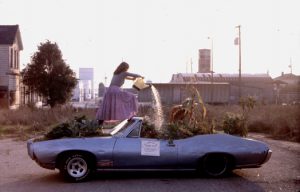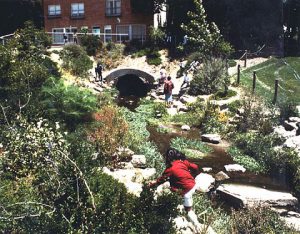
Richard Register’s 1979 Vegetable Car in honor of Henry H. Bliss, first auto fatality.
Founded in 1992 by ecocity pioneer Richard Register and a core group of ecologists and activists in order to further a set of specific goals outlined at the first International Ecocity Conference in Berkeley in 1990, Ecocity Builders continued to advance the body and practice of the ecocity movement that had began in 1975 with Register’s previous nonprofit, Urban Ecology.
Utilizing ecological urban planning, design, ecology, education, advocacy, policy and public participation to build healthier cities for both people and nature, Ecocity Builders’ early years were characterized by a number of local projects in the San Francisco East Bay.
For example, the Codornices Creek Project in 1994 that removed the water channel from its cement culvert along the Albany/Oakland border to create a mile-long park signified one of the earliest daylighted and restored creek beds in the United States.
During that time, Ecocity Builders also helped plan and provided support for a variety of small to medium sized depaving projects in Berkeley. Accomplishments included a garden to replace five parking spaces at the University Avenue Homes’ low income residence, as well as the conversion of a 28 space parking lot into a community-designed mini-park at Halcyon Commons.

Strawberry Creek Park Daylighting, West Berkeley
Over the years, many more projects would help define and refine “pieces of the ecocity,” providing living laboratories and models for practitioners in the emerging field of ecocity development. A street was redesigned as a “Slow Street,” a new bus line was established, street side fruit and nut trees were planted, and buildings were designed to feature rooftop access and greenery with views to nature.
Through its advocacy work, Ecocity Builders also began to lobby for and successfully co-author policies in Berkeley that are currently enforced, including the Ecocity Amendment to the 2001 General Plan, the Solar Greenhouse Ordinance, and the Residential Energy Conservation Ordinance (RECO).
In the mid 2000s, Ecocity Builders first began employing GIS mapping techniques to identify active urban nodes that could serve as Eco Districts. Based on a method for identifying urban villages in large urban areas that had first been piloted in Richard Register’s 1987 book Ecocity Berkeley, a project commissioned in 2009 by the Bay Area Air Quality Management District entitled Ecocity Mapping for Urban Villages would turn out to be the catalyst for Ecocity Builders’ more recent ventures into the web-based mapping and data visualization tools as developed through its Urbinsight platform.
These projects have not only created physical features, functions and established new laws, but have stimulated discussion of larger eco-urban issues and implications as well, leading to the creation of our current flagship projects, the Ecocity Framework & Standards Initiative and Urbinsight.
Through it all, Ecocity Builders has managed to convene Ecocity World Summits in Australia, Senegal, Brazil, China, India, San Francisco, Turkey, Canada, France, and the UAE, poised to convene for the 12th time in Vancouver, B.C. October 2019.



